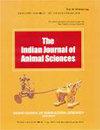Phenotypic attributes and production performances of Agonda Goan pig
IF 0.3
4区 农林科学
Q4 AGRICULTURE, DAIRY & ANIMAL SCIENCE
引用次数: 0
Abstract
The aim of study was to evaluate morphometric traits, growth and reproduction performance of indigenous Agonda Goan pigs reared under coastal climate which supports livelihood development of resource poor farmers. Population size in breeding tract varied depending on farmers’ preference for breeding and consumers’ demand for pork. Data (n=74) on different parameters were recorded both from farmer’s flock and institute pig unit. Body measurements such as body length, height at withers, chest girth and neck girth of both were measured using measuring tape. The body weights at different ages i.e., birth, weaning and monthly interval up to one year of age were recorded using digital weighing balance. The average body length, chest girth, height at withers and neck girth were 102.68±3.22 cm, 99.86±3.64 cm, 58.32±1.19 cm and 73.09±4.18 cm, respectively. The mean bristle yield (g/cutting), bristle length(cm) and bristle diameter (micron) were 38.08±5.85, 4.45±0.04 and 268.21±9.84 in males, and 88.16±16.95, 5.69±0.07 and 270.93±11.07 in female pigs, respectively. The mean weight at birth was 0.59±0.01 kg and at weaning was 3.76±0.12 kg. The yearling weights of adult male and female were 46.58±4.50 and 47.27±6.46 kg, respectively. The average litter size at birth and at weaning was 7.21±0.41 and 5.93±0.28, respectively. Pre-weaning and postweaning growth rates were 79.25±9.86 and 153.85±13.34 g/day, respectively. This unique germplasm has potential for sustainable production with improved pig breeding programs. However, the breed is under constant threat due to indiscriminate crossbreeding with unbalanced admixture and replacement with exotic breeds for which immediateconservation and improvement programs are essential to save the breed.阿贡大果阿猪表型性状及生产性能
本研究旨在评价在沿海气候条件下饲养的阿贡达果阿猪的形态特征、生长和繁殖性能,以支持资源贫乏农民的生计发展。养殖场的种群大小取决于养殖户对养殖的偏好和消费者对猪肉的需求。记录了来自农民畜群和研究所养猪场不同参数的数据(n=74)。身体测量如体长、肩高、胸围和颈围都是用卷尺测量的。使用数字称重秤记录不同年龄的体重,即出生,断奶和每月间隔至一岁。平均体长102.68±3.22 cm,胸围99.86±3.64 cm,马肩高58.32±1.19 cm,颈围73.09±4.18 cm。公猪平均猪鬃产量(g/次)、猪鬃长度(cm)和猪鬃直径(微米)分别为38.08±5.85、4.45±0.04和268.21±9.84,母猪平均猪鬃长度(cm)和猪鬃直径(微米)分别为88.16±16.95、5.69±0.07和270.93±11.07。出生时平均体重0.59±0.01 kg,断奶时平均体重3.76±0.12 kg。成年公、母鼠初生体重分别为46.58±4.50和47.27±6.46 kg。出生和断奶时平均产仔数分别为7.21±0.41和5.93±0.28。断奶前和断奶后的生长速率分别为79.25±9.86和153.85±13.34 g/d。这种独特的种质资源具有通过改进生猪育种计划实现可持续生产的潜力。然而,由于不平衡的杂交和外来品种的替代,该品种受到持续的威胁,因此立即保护和改进计划对拯救该品种至关重要。
本文章由计算机程序翻译,如有差异,请以英文原文为准。
求助全文
约1分钟内获得全文
求助全文
来源期刊

Indian Journal of Animal Sciences
农林科学-奶制品与动物科学
CiteScore
0.60
自引率
25.00%
发文量
220
审稿时长
8 months
期刊介绍:
Articles published in The Indian Journal of Animal Sciences encompass a broad range of research topics in animal health and production related to cattle, buffalo, sheep, goat, camel, equines, pig, rabbit, yak, mithun, poultry and fisheries. Studies involving wildlife species and laboratory animal species that address fundamental questions about their biology will also be considered for publication. All manuscripts must present some new development and must be original, timely, significant and scientifically excellent. Papers will be rejected if standards of care of, or procedures performed on animals are not up to those expected of humane veterinary scientists. At a minimum, standards must meet the International Guiding Principles for Biomedical Research involving Animals, as issued by the Council for International Organizations of Medical Sciences. (C.I.O.M.S., c/o WHO, CH 1211 Geneva 27, Switzerland). Articles reporting new animal disease must follow GOI directive as given in detail in Guidelines to Authors.
 求助内容:
求助内容: 应助结果提醒方式:
应助结果提醒方式:


